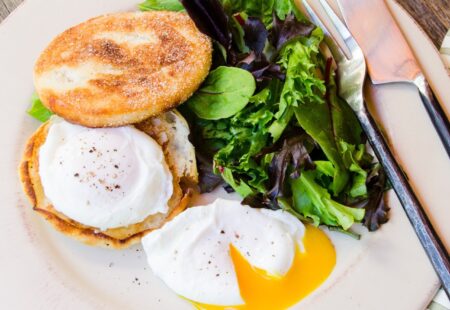Start with the freshest eggs you can find when you’re poaching eggs. A fresh egg will have a firmer white and therefore give you fewer whisps of white in your poaching liquid. You can strain your raw eggs through a fine strainer to ensure you are only poaching the firmest white.
Ensure that your poaching water is just barely simmering – just seeing a few bubbles on the bottom of the pan is sufficient. Crack the eggs into a bowl before putting them into the water – that will make the transition much easier.
Eggs will only take about 2 to 3 minutes to poach. When the yolk is done to your liking (push on it with your finger to see how soft or hard it is), remove the eggs with a slotted spoon and dry lightly with a clean paper towel before plating it.
If you’re planning a brunch, you can actually make your poached eggs ahead of time. Poach them to your liking and then transfer them to a bowl of ice water. Store them in the ice water until you’re ready to serve and then simply re-heat them in simmering water for about 30 seconds.
Basic Instructions:
- Bring about 1½- to 2-inches of water to a boil in a wide deep sauté pan or Dutch oven and then turn the heat down to a simmer.
- One at a time, crack each egg into a ramekin or small bowl.
- One at a time, gently slide each egg from the bowl into the water.
- Time the eggs for 2 to 3 minutes, depending on how well done you want the yolks cooked.
- Remove the eggs with a slotted spoon and test for doneness just by pushing on the yolk gently with your finger. Gently pat the egg with a paper towel to dry it before serving.
Quick Notes:
- The freshest eggs are the best because the whites are firmer and stay together better.
- The poaching water should be at a bare simmer – just a few bubbles on the bottom of the pan.
- Adding vinegar may help keep the whites together, but you’ll have a slight vinegar taste.
- Test for doneness by pushing on the yolk with your finger to feel how firm it is.
- Dry the poached egg well with a paper towel.






